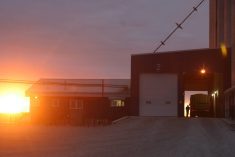PORTUGAL COVE, N.L. – Michael Murray had an epiphany of sorts one cold winter day while he walked in downtown Winnipeg.
“It must have been minus 50 and I thought, if they can grow ornamentals in this Jesus climate, why can’t I do it in Newfoundland?” says the fifth generation N.L. farmer. “We have crappy weather but a great climate. I saw an opportunity.”
The word “opportunity” is sprinkled through a conversation with the 53-year-old businessman whose farm west of St. John’s has been owned by family members since the 1820s.
Read Also

Producer profits remain under significant pressure
Manitoba farmers are facing down a double hit of high input costs, like fertilizer, and low grain prices as they harvest their next crop.
Over the years under his stewardship, the 150 acre farm has morphed from a vegetable operation to an ornamental flower, bedding plant and landscaping centre with a roadside garden centre. The company has done high-profile landscaping projects in the capital city and dreams of being able to ship plants across Canada and North America.
Murray’s interest in using his greenhouses to grow trees and flowers native to Newfoundland has given his company a market niche.
His growing staff of more than 50 includes professional horticulturalists, botanists and stonemasons. The operation has annual revenues of more than $2 million.
Murray hopes that one day his son Tim will return from Western Canada to become the sixth family generation to own the farm. Tim has studied landscape architecture and is working now in a stone masonry business in British Columbia.
“That is my dream,” says the father. “He is the future.”
But Murray also is deeply rooted in the past of Newfoundland and his family history there. The farm recently received a century award from the Agricultural History Society of Newfoundland and Labrador. The irony is that the designation is too modest. Murray ownership of that slice of land dates from 185 years ago.
Irish brothers Pat and Mike came to the island in 1815 from Waterford, Ireland, as indentured servants and within a few years had paid off their debt or somehow escaped. Mike moved to the Irish communities of the Ottawa Valley while Pat moved to land in the community that was named after an early Portuguese explorer.
Over generations, the Murray farm produced goats to be taken for milk and protein on fishing and trading boats, vegetables for the local market and mink for the fur trade. It had dairy cattle and root crops and one ancestor developed a trading business, taking salt cod from Newfoundland to Jamaica for sugar and rum and then to England for goods needed on the island.
It used capelin fish, ash and peat to form organic compost for the land.
And the family played a role in island politics, siding with Joey Smallwood on the side of confederation with Canada in 1949.
Michael’s father Pat was a soil scientist hired by Newfoundland’s government in the 1930s to sample soils throughout the island trying to determine the best sites for agricultural development.
Under Smallwood, Pat Murray became deputy minister of natural resource departments including agriculture, but had a falling out with the premier in the mid-1960s over agricultural development policies. He left the well-paid government position to return to the farm, where times were tough.
But Michael credits him with a decision that kept the farm in the family.
There were arguments to divide the farm among all the children. Pat decided it should be kept as a unit to be viable and Michael got it.
“He kept the tradition alive, not out of necessity, but out of reverence and joy,” said Michael of his father. “We have a saying here that when the arse goes out of her, you can always go back to the farm. That was his philosophy.”
Michael’s philosophy was more a holdover from the “hippie myth, back to the land.”
So in 1977, he and his wife Susan moved back from Ontario, created a home in what had been the mink skinning building and tried to run a roadside vegetable stand: “It was a miserable business.”
Then he tried growing romaine lettuce on contract to a local supermarket chain that eventually reneged on the contract and that forced him to plow down acres of the crop. It soured him on the powerful concentrated side of the agribusiness industry.
“I learned quickly that you can’t trust the SOBs,” he said. “They are not honourable.”
Later, he contracted with Kentucky Fried Chicken in Newfoundland to supply cabbage for salads. The price kept falling and he couldn’t make a living.
By then, the idea of using his land to grow high-value ornamentals had taken root.
“We don’t do vegetables any more,” he said. “It’s a question of economics, what value can you get out of a square foot of production with low value vegetable or ornamentals.
“The hippie myth of being on the land stuck with us but it has become a business.”
Soon, the fifth generation Murray on the land will become president of the Canadian Nursery Landscape Association.
He figures his ancestors would be proud.
“The farm is still viable, we are adapting and we are creating jobs. I don’t think they’d be upset that we’ve moved away from their idea of farming because they always were adapting too.”
















